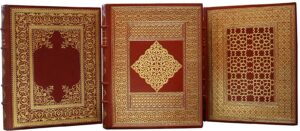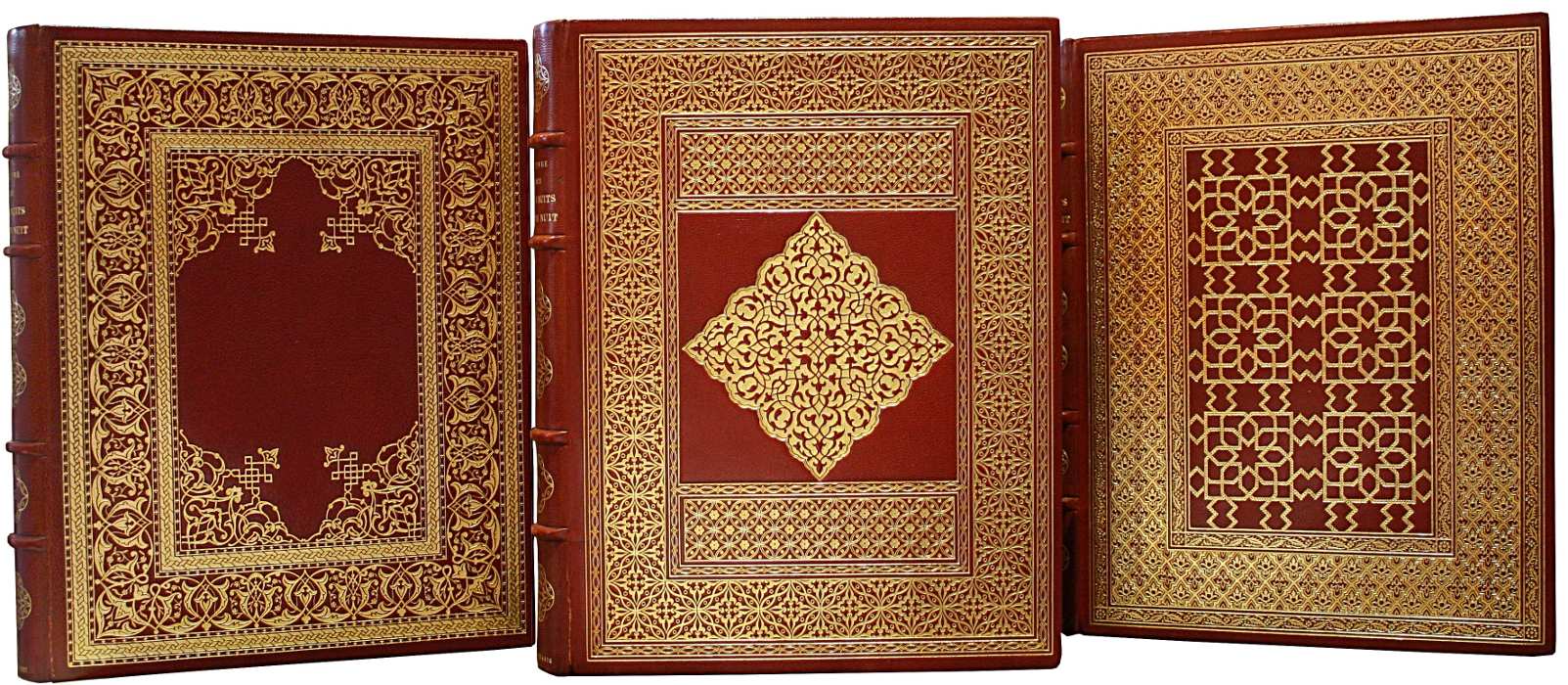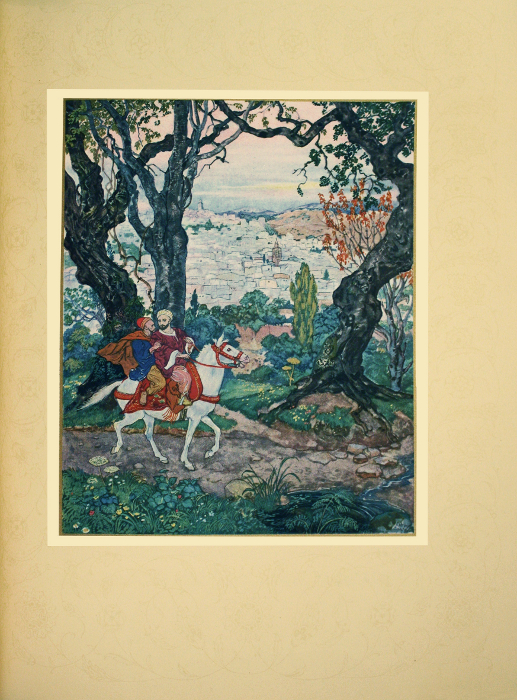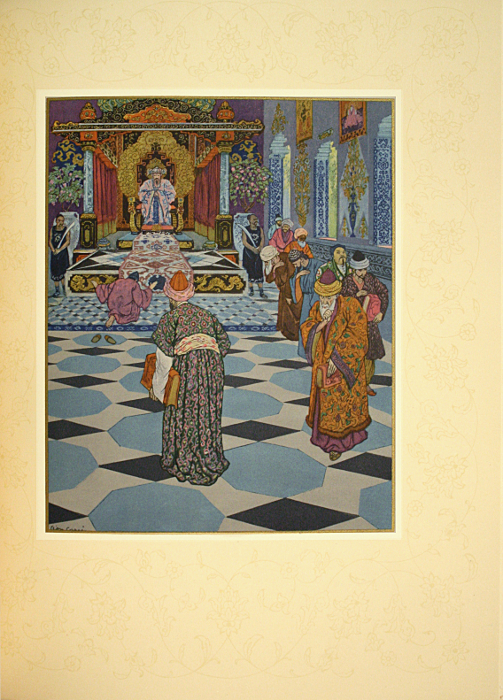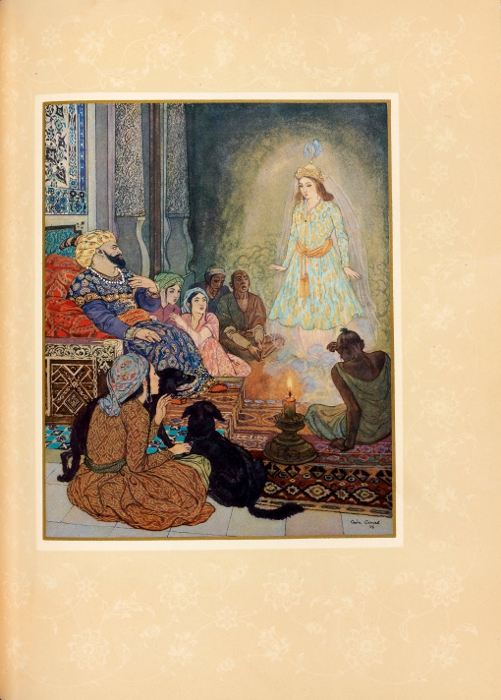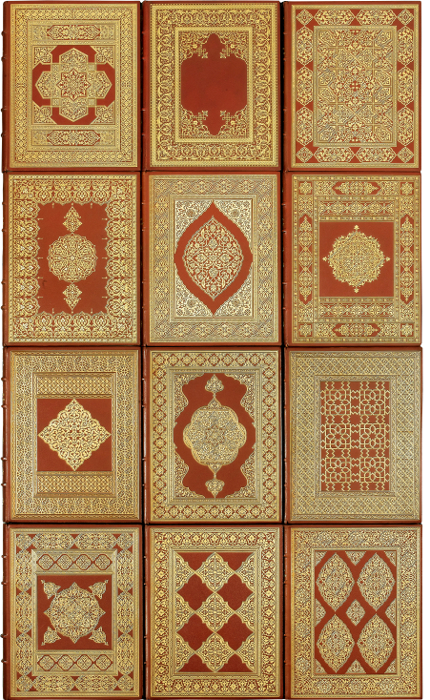Paris, L’Edition d’Art H. Piazza, 1926-1932.
12 parts in 12 volumes large 4to [298 x 228 mm]. 144 illustrations in colors and gold out of pagination, some covered with silky papers, and 85 ornamentations. Bound in full red morocco, sides richly adorned with a beautiful gilt-stamped panel with oriental design different for each volume, spines ribbed decorated with gilt fleurons, date on foot of spines, top edge gilt, triple gilt fillet and blind-stamped filet on the inside, corner pieces with gilt rose-like ornaments, red watered silk endleaves, wrappers illustrated in color heightened with gold and spines preserved. Cases. Binding signed and numbered by René Assourd.
Sumptuous edition of “the Thousand and One Nights” illustrated by Léon Carré. Carteret, Le trésor du bibliophile: livres illustrés modernes, 1875 à 1945, IV, p. 281.
“Beautiful publication much sought-after and highly rated”. (Carteret).
In this French edition of The Thousand and One Nights, the French artist Léon Carré was entrusted with the miniature paintings and Mohammed Racim with the illumination.
Léon Carré (Granville 1878 – Alger 1942) is a French Orientalist painter and illustrator who has a solid reputation at that time. He was the student in Rennes of Mathurin Meheut, but also in Paris of Leon Bonnat and Luc-Olivier Merson. By being in contact with the Orient, he becomes the painter we know: charmed during his first trip to Algeria in 1905, he settles in Algiers thanks to the grant of the Villa Abd-el-Tif that he wins in 1909, and he will never leave the city. He practices the oil, gouache and pastel. The other great man of this edition is the decorator Racim Mohammed (1896-1975). He spent eight years designing the ornaments of The Thousand and One Nights. Using patterns inherited from the Maghreb but also from Iran and Turkey, this Algerian artist reinvents the traditional art of decoration. His paintings renew the genre of miniature by introducing Western techniques such as perspective or relief.
The superb illustration in first state is made of 144 out of pagination colored and gilt plates drawn by Léon Carré and of 85 decorative compositions in color in oriental style by Racim Mohammed. For each tale, the illustrated title is presented in French in full-page, and then on the next page in Arabic, in a cartouche. Every page is decorated with oriental frames in red, blue and green.
2500 numbered copies were printed. Our copy, one of the 2200 on “velin chiffon” is numbered 1954.
“In the history of ‘the Thousand and One Nights’, the translation by Madrus is important. Thanks to it, the text got a new lease of life and was brought to a new audience. Some people discover them, others rediscover them, but through the phenomenon it arouses, often qualified as stunning, outside the text itself it is a complete lure for the East of the ‘Arabian Nights’ which appears in all environments at that time…
Mardrus was born in Cairo in 1868. In 1878 he left Cairo for Beirut. In 1893 he left Lebanon for Paris, where he graduated in 1894 from a doctoral degree in medicine. It was then that he began to go around with literary circles. From 1894 to 1899, he enlisted as a medical officer with Marine Messaging. The doctor will travel, and enjoy the stops to soak up the flavors from the end of the world. In fact, it is during this period and on the sea that Mardrus wrote his “Thousand and One Nights”… Between1899 and 1904, twelve volumes went out in the ‘Revue Blanche’, out of the 16 volumes that would compose ‘The Thousand and One Nights” – only twelve because the review stops existing in 1904.
It is a stunning success, in term of recognition from the artistic and society circles, but also on a financial level… This is not only in social circles, but in literary circles too that Mardrus finds his first support from members of the ‘Revue Blanche’ – and particularly Mallarme. From 1894, the “Revue” is powerful enough to become also a publisher and so ‘The Thousand and One Nights’ is edited by the ‘Revue Blanche’. Mardrus can count on this sympathy and on the emulation between young bold authors, who wrote for an audience made of informed bibliophiles. He also got support from Mallarme. That is why his text, sent from the Marine Messaging, was published that quickly – even if Mardrus was not famous yet. The influence of mardrus on the perception of “the Nights” is very important. He had an impact on people of his time, who were charmed by his translation and by all the events that came with it in the cultural and social circles. They entered the world of dandies… (R. Léostic, Les éditions illustrées de luxe des ‘Mille et une Nuits’ dans les années 1920).
A superb copy of this sought-after publication, preserved in twelve sumptuous bindings signed and numbered by René Aussourd, each one of them decorated with a particular gilt-stamped panel with oriental design. Pupil of his uncle, Charles Meunier, former first gilder at Chambolle-Duru’s, Rene Aussourd started his own business in 1912.
